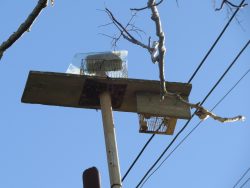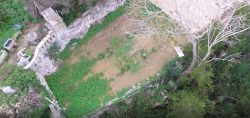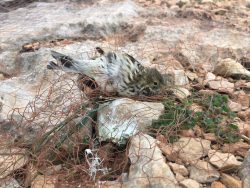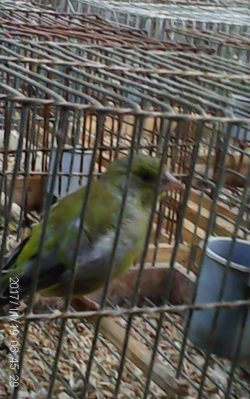Evidence collected by BirdLife Malta indicates that enforcement has been slow and at times absent in the last trapping season, giving trappers a field day over the last two and a half months with police inefficiency and their lack of response being the order of the day.

Live decoy finches spotted from one of the Buskett car parks. This was reported to the ALE but no response was received. Photo by BirdLife Malta
Between October and December 2017, the Maltese Government opened two trapping seasons for seven species of finches as well as for Golden Plover and Song Thrush. With circa 4,000 trappers licensed for the season and 8,000 trapping sites authorised by the Wild Birds Regulation Unit (WBRU), enforcement of the season has relied upon the Administrative Law Enforcement (ALE) Unit in Malta and the District Police in Gozo who on multiple occasions during the past season, have failed to prosecute on evidence presented by BirdLife Malta.
Investigations were made on several Sunday mornings last November at the Floriana markets, which revealed at least five vendors were illegally selling wild finches (not possessing closed rings) from their stalls. These markets are just metres away from the ALE headquarters. All vendors – a proportion of which hail from Gozo pet shops who have previously faced prosecutions on the illegal trade of finches – were reported to the police. However, searches held ten days after resulted in just two birds being seized for further inspection by the WBRU. Requests filed with WBRU over the nature of their investigations remain unanswered, while police sources have admitted to not having the capabilities of distinguishing wild birds from captive ones.
“The situation at the markets this year has been such a free for all that we have witnessed not just the usual vendors we report year after year, but even trappers, who have had a good catch of finches during the past season, selling their catch directly at the market,” commented Nicholas Barbara, Conservation Manager at BirdLife Malta.
The finch trapping season allowed a quota of 10 wild finches per trapper, with a possibility to use a further 21 caged birds to lure wild ones to trapping sites. Selling wild finches is illegal, yet each trapping season creates such a huge demand for live decoy birds, that this results in local trade and smuggling of finches from nearby Italy.
Reports filed to the authorities over the last season also included finch trapping sites located within protected areas. In December, BirdLife Malta was alerted by members of the public in disbelief at the fact that a trapping site was operating next to the main canopy at Buskett bird sanctuary. Photographic evidence of the site was passed on to ALE officers.

Active finch trapping site within Buskett bird sanctuary as seen from the air. This site too was reported to the ALE but no response was ever received. Photo by BirdLife Malta
“This trapper in question was acting with such impunity that decoy birds used to lure wild finches to his trapping sites could actually be seen from the popularly frequented Buskett ‘tinda’. With all the numerous inspections on trapping sites the Wild Birds Regulation Unit reports to the European Commission every year, how could a trapper operate in a protected area under the authorities’ noses?”, remarked Nicholas Barbara. To date, no response has been received by the police over this case.
On the island of Gozo, the situation with enforcement was no different. Reports filed with police over nets left unattended within the Xlendi Natura 2000 site, remained unanswered even though BirdLife Malta demanded the attention of police to nets that were causing the entanglement of other wildlife. This was known to happen after the discovery of a trapped protected species, a Meadow Pipit, in another unattended net within the Ta’ Ċenċ Natura 2000 site.

This Meadow Pipit was caught in an unattended net in Ta’ Ċenċ (Natura 2000 site). Luckily this bird was found in time and released unscathed. Photo by Nadja Tschovikov
“Enforcement authorities have this year more than ever showed a reluctance in prosecuting even when presented with hard evidence. This has been tantamount to a situation where trappers have been allowed to operate for the last season under no supervision,” remarked Mark Sultana, BirdLife Malta’s CEO. He added that irrespective of any statistics which will eventually be issued by WBRU, it is the results that matter.
Finch trapping seasons in Malta are opened by way of derogations applied by the WBRU. The Unit files a report on the season to the European Commission every year, despite the fact that the very practice is currently being contested at the European Court of Justice (ECJ) with the verdict of the case initiated by the European Commission against Malta now imminent. BirdLife Malta has requested the ALE and WBRU to present their results on ‘enforcement’ of the trapping season at the next Ornis Committee meeting scheduled for the 24th of January.
In response, BirdLife Malta has just launched #STOPTRAPPINGNOW, a public campaign aimed at raising more awareness about the negative impacts of trapping on birds and other wildlife, their habitats and the Maltese environment in general.
Read the Maltese version of the press release here.

